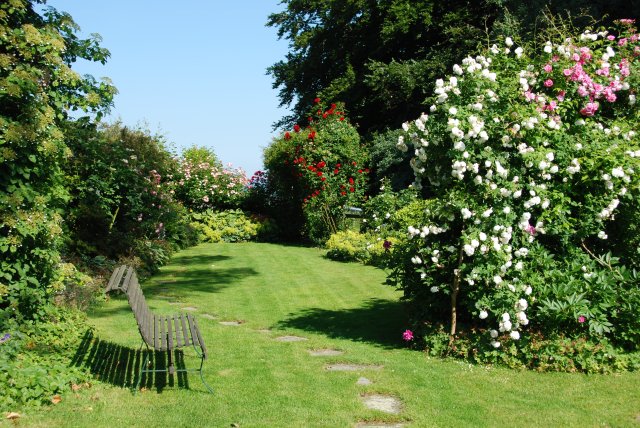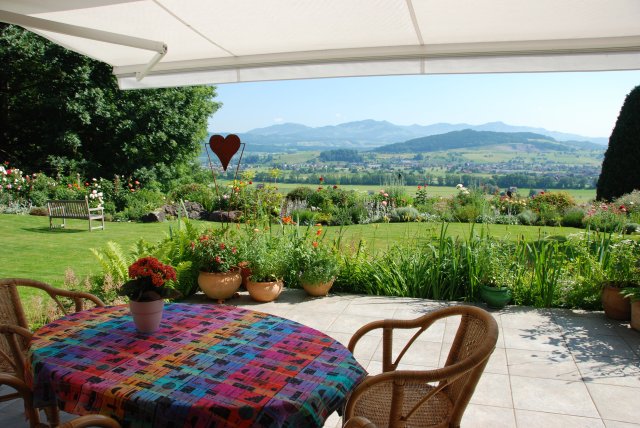Heidrunís Garden
 Towards
the west, the garden becomes narrower, an archway covered with the Immensee rose
and honeysuckle opens onto the road. On the shady slope side rhododendrum,
azalaeas punctuated with the delicate arching branches of white spireas make
this a highlight in May to be succeeded by hydrangeas later in summer. Two very
tall pine trees throw their shade in late afternoon, their trunks covered in ivy
and a climbing white hydrangea, its leaves turning bright yellow in the fall.
From there a path leads up to the top level, bordered by bluebells, hostas, and
saxifraga in spring, dark blue geraniums in summer and white lysimachia in the
fall. A narrow piece of lawn follows the length of the house, flanked by an old
stone wall towards the slope. Variegated plants - weigelias and hostas - as well
as a light pink New Dawn and a white rugosa rose lighten the dark of the hedge
closing out the road above us. Further shade loving plants like helleborus,
epimedium, cimcifuga and white geraniums give the bed a different appearance
throughout the seasons.
Towards
the west, the garden becomes narrower, an archway covered with the Immensee rose
and honeysuckle opens onto the road. On the shady slope side rhododendrum,
azalaeas punctuated with the delicate arching branches of white spireas make
this a highlight in May to be succeeded by hydrangeas later in summer. Two very
tall pine trees throw their shade in late afternoon, their trunks covered in ivy
and a climbing white hydrangea, its leaves turning bright yellow in the fall.
From there a path leads up to the top level, bordered by bluebells, hostas, and
saxifraga in spring, dark blue geraniums in summer and white lysimachia in the
fall. A narrow piece of lawn follows the length of the house, flanked by an old
stone wall towards the slope. Variegated plants - weigelias and hostas - as well
as a light pink New Dawn and a white rugosa rose lighten the dark of the hedge
closing out the road above us. Further shade loving plants like helleborus,
epimedium, cimcifuga and white geraniums give the bed a different appearance
throughout the seasons.

The concept that something is always in flower applies to the
entire garden. From the snowdrops, the deliciously scented lonicera and
virburnum bushes in early spring to the peonies, the almost 200 roses and 30
clematis to the asters in fall, there is always a flower to please the eye.
Emphasis has been placed on a natural harmony - 'as if the plants have chosen to
live there' - which they often do anyway. Even though the plantings vary in
character, they melt into each other giving the garden a natural flow.